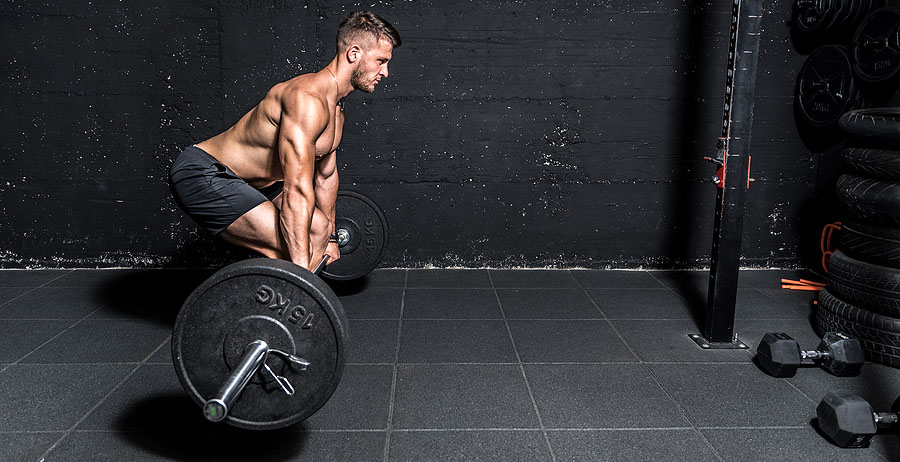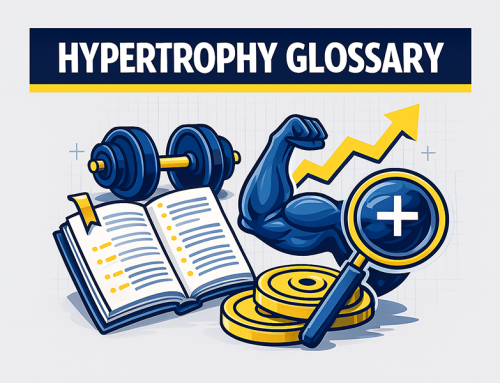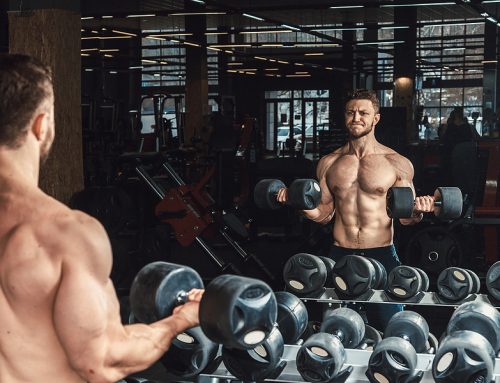Can You Really Gain Muscle Lifting Only Two Days a Week?
How do you get stronger, improve your maximum lifts and also improve your physique overall if you only have two days a week to dedicate for lifting? What’s the best approach to weight training when increasing both strength and muscle is the goal but you have extremely limited time?

Some people might tell you that twice a week training is not enough to make gains, but there is actually research on low frequency weight training showing very good gains can be made with just two well-designed workouts a week.
It’s true that you would certainly make even better strength and muscle gains with more frequent training. However, studies have shown that 70% or 80% of the gains that were made from more frequent training were achieved with only two full-body workouts per week.
Avoid All Or Nothing Thinking About Training Frequency
Of course, serious athletes want 100% of the possible gains they can get, but getting 80% of the potential gains from an extremely modest time commitment is a pretty amazing trade off.
This is really valuable information for busy people to know about (It helps you avoid “all or nothing thinking” like, “If I cant train my usual 5 days a week, I might as well not train at all.”)
If you’re going to scale back to only two workouts a week and you also want to keep the workouts short, you have to limit yourself to a small handful of exercises, as few as three or four per workout.
In Minimalist Routines, Focus Mostly On Compound Exercises
You are not going to do a lot of isolation or detail exercises the way competitive bodybuilders usually do (which keeps them in the gym for many hours a week). All your exercises should be compound movements that work large areas of muscle mass, mostly barbell and dumbbell basics and powerlifts.
Extra exercises for small muscle groups like arms, abs and calves could be added if you feel you’re weak in any of those areas and if you have the time, but they’re not mandatory. You’ll mainly focus on the major movement patterns such as squatting, pushing and pulling.
Many people call this abbreviated training or minimalist training, and it doesn’t seem like much at first glance. But while these big exercises don’t require much time, they demand a lot of effort from you. If you work hard at progressive overload, keeping a training journal and adding reps or weight at every workout, you can make really solid gains with minimum time invested.
Use Exercise Rotation To Hit Muscles From Different Angles And Avoid Boredom
When you’re only doing a few basic movements per workout, it’s also a good best practice to rotate exercises. Instead of doing the same exercises on both days, you alternate two different workouts.
Each workout trains your whole body, but with different exercises each time. This gives you more variety so more movements and muscle areas are worked each week, it may prevent overuse injuries and joint pain, it helps prevent you from getting bored and lets you keep making progress longer before you reach a plateau.
Example Of A Minimalist Routine When You Have very Litle Time (With Sets Reps, And Exercises)
The most basic two-day a week program has just three exercises per workout for three sets of 8 to 12 reps, except for deadlifts which are 4 to 6 reps (because deadlifts are extremely taxing on the body and more suited to low reps. If you prefer the 8 to 12 rep range and you can recover from that volume of deadlifting that’s your call).
Workout A
1. Squat 3 X 8-12
2. Bench press 3 X 8-12
3. Deadlift 3 X 4-6
Workout B
1. Split Squat 3 X 8-12
2. Overhead press 3 X 8-12
3. Chin Ups* 3 X 8-12
* If chin ups can’t be performed, then a barbell row or inverted row can be substituted
It doesn’t take long at all to finish three exercises for three sets each, so even the busiest person can do this, but it is hard work because these are tough exercises and you have to keep progressing (more weight or at least more reps every workout).
Example Of A Minimast Routine When You Have A Moderate Amount Of Time
If you have a little more time available, a fourth or even a fifth exercise could be added and the workouts would still be very brief, though additional exercises are optional. You could also get extra exercises done quickly by supersetting. Here’s a sample routine, and you could very easily superset the dips with the barbell curls and the hyperextensions with the hanging leg raises.
Workout A
1. Squat 3 X 8-12
2. Bench press 3 X 8-12
3. Deadlift 3 X 4-6
4. Dips 3 X 8-12
5. Barbell Curl 3 X 8-12
Workout B
1. Split squat 3 X 8-12
2. Overhead barbell press 3 X 8-12
3. Chin ups* 3 X 8-12
4. Hyperextension 3 X 8-12
5. Hanging leg raises 3 X 10-15
* if full chin ups cant be completed with body weight, a barbell row or inverted row can be substituted
Progressive Overload Is A Must
Your goal is to add weight at every workout when possible and when you can’t increase the weight, try to do just one more rep with the same weight.
The double progressive system is a great way to slowly but surely keep moving forward. Start with the lower number of reps at a given weight – which is 8 reps for most exercises – keep adding reps with the same weight until you hit the upper repetition number – which is 12 in most cases – then increase the weight and drop back down to 8 reps. Then keep repeating the process.
This program does not have a specific end date. Simply stay with this program as long as you can keep adding weight or reps at every workout (because if you can keep adding weight or reps, the program is still working).
It’s difficult to predict how long that will take, but usually beginners can keep making gains longer, and experienced lifters with years of experience plateau sooner. It’s likely that the average trainee will get about three months of steady forward progress of this type of program.
How To Change Up A Minimalist Strength Training Program To Get Past Plateaus
When you reach a progress plateau, you should make some program changes to help restart your gains again. Here are a few good options for that.
One, if you want to keep doing the same exercises, you can take two steps back in poundage, which we call a deload and then work back up. Sometimes the 2 steps back, 3 steps forward strategy helps you keep progressing on the same exercises.
Two, you could keep the same exercises and change the set and rep structure. For example, you could change to 3 to 5 sets of 5 reps on the basic exercises, using heavier weights at every workout, or you could alternate rep ranges every other week with week one at 4 to 6 reps and week two at 8 to 12 reps.
(Note: people who want maximum strength or who are interested the powerlifting style of training may want to use a lower repetition bracket, like 3 to 6 reps, with much heavier weights, right from the start.
Performing 8 to 12 repetitions is an ideal bracket for muscular development as well as strength.
A third option is to keep the sets and reps the same and simply change your exercises. For example, a new program with the same overall structure might look like this:
Workout A
1. Front Squat or Goblet Squat 3 X 8-12
2. Dumbbell Hang Clean and Press 3 X 6-10 per side
3. One Arm Dumbbell Row 3 X 8-12 per side
Workout B
1. Walking Lunges 3 X 8-12 per leg
2. Incline Dumbbell Bench Press 3 X 8-12
3. Romanian Deadlift 3 X 8-12
Minimalist Lifting Routines For Athletes
One last thought: This kind of minimalist two days a week training is not just good for busy people, it’s a good option for people who are very active in other sports who spend a lot of time practicing or playing their sport.
For example, cyclists, runners or martial artists might do so much training for those activities that lifting weights four or five days a week is overkill. Trying a twice a week program might be ideal, and the exercises could be tweaked slightly to make them more sports specific.
– Tom Venuto,
author of Burn The Fat, Feed the Muscle.
PS. By the way, this two-day minimalist strength and muscle program can in fact be performed three days a week and there is a good chance you will get even better gains from a third workout, yet the time investment is still quite modest. In the other direction, if you only did this type of training once a week, it would be even further from optimal, but it could be enough to maintain the muscle you already have.
PPS. For more great workout programs, join us at Burn the Fat Inner Circle, where the members-only area is constantly updated with new training plans, workout tips and expert exercise instruction: Visit: www.BurnTheFatInnerCircle.com
Related Articles:
Time Efficient Strength Training For Busy People
How Many Days A Week Should You Train For Max Muscle?
Supersetting To Gain More Muscle In Less Time

Tom Venuto is a lifetime natural (steroid-free) bodybuilder, fitness writer and author of Burn The Fat, Feed The Muscle: Fat Burning Secrets of Bodybuilders and Fitness Models and the national bestseller, The Body Fat Solution, which was an Oprah Magazine and Men’s Fitness Magazine pick. Tom has appeared in The New York Times, Wall Street Journal, Huffington Post, Oprah Magazine, Muscle and Fitness Magazine, Ironman Magazine and Men’s Fitness Magazine, as well as on dozens of radio shows including Sirius Satellite Radio, ESPN-1250 and WCBS. Tom is also the founder and CEO of Burn The Fat Inner Circle – a fitness support community for inspiration and transformation






Great article, Tom! This routine is perfect for my schedule.
How much rest in between sets though?
given that this is aimed at busy people, you might be tempted to shorten the rest intervals. BUT…. most of the recent research confirms that 2 minutes between sets (min) will optimize your strength and performance. when your rest intervals are too short, yes you get done faster ,but you compromise on weight lifted because there is still residual fatigue from the last set. This type of routine uses basic heavy exercises but not very many and not many days a week are required, so Id recommend sticking to straight sets and take all the time you need between sets so that you can use the most weight on each exercise. Auto-regulate your rest intervals and go when you are ready, but not before
Very good article Tom! The 1st example is very similar to my 2x/week routine. I’m in my 50’s and make steady gains despite my very limited time. I encourage many people to train this way, whether they have hectic schedules or not. 3-5 days a week hitting the gym is extremely difficult mentally and physically (compliance) for all who want to train but aren’t passionate about the iron (like us). I WISH I could be under the bar 3-4 times per week but it’s simply not possible these days.
Right on dave. So much, sooo much research pointing to higher frequency building more muscle, up to really high amounts of volume, but most people cant sustain them practically even if they can physically. This point that a very minimalist routine can get you 80% of the results is not brought up enough I think. I’ll be putting it to the test myself this summer
Good luck Tom on the Pacific Crest Trail! Brutal terrain!! I have seen and read interviews of people who have completed this journey and it’s reported to be life changing. Some of the most important gear recommended…the right socks and foot wear (including a roll of duct tape for emergencies). Crucial!! Stay safe and I will pray for you and your feet!! :)
Thanks donna. Ive spent the past 9 months testing gear including shoes – you are totally right about the right shoes and socks. Now… lets see if I can manage to pull off a couple lifting workouts a week too (when I go into town to resupply food). Cheers!
Wasn’t going to come back to this blog but could not NOT to relate to the ‘Great Hike’ news.. Who doen’t fall in love with CA mountains! Lliving in Santa Clara, LOVE hiking myself, although being originally from Siberia, where URAL mountains are pretty cool too!
That’s going to be quite a pre-exhaustion, to hike all day before a workout, even twice a week. Main challenge will be REST! Don’t think all these small towns have aminos or HMB… better stock up… And hope we don’t have to tell you to supplement with Na, K, Mg, and Vit C (for connective tissue) in the end of the day :)
Post some frogs pictures – might still observe some rare ones left as majority of them disappear because of humans’ BPA pollution…
Thanks for the routine. I hope I follow this time seriously.